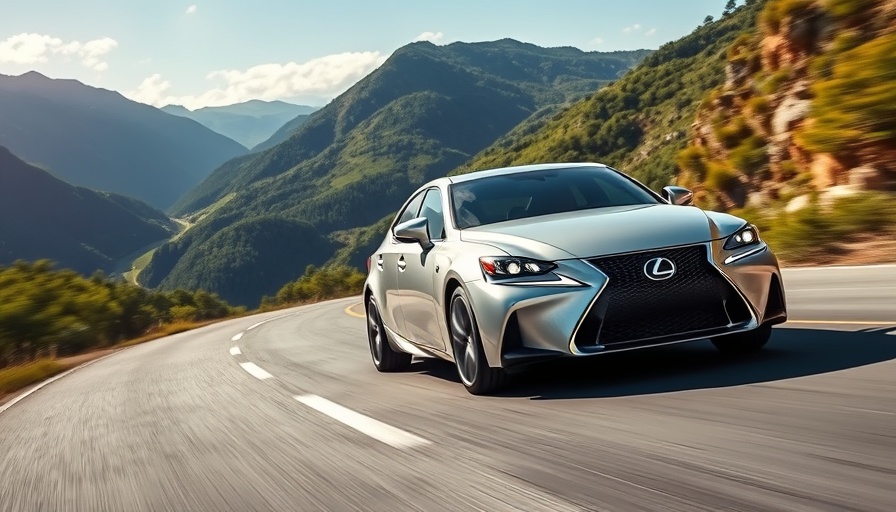
Introducing the 2025 Lexus IS Ultimate Edition
The automotive world is buzzing with excitement as Lexus unveils the 2025 IS Ultimate Edition, a model poised to demonstrate the brand's commitment to performance and luxury all in one package. This edition comes equipped with a potent 472-hp, 5.0-liter V-8 engine, an exhilarating boost for enthusiasts eager to feel the thrill of a rear-wheel-drive (RWD) sedan. The new dual exhaust gives it a robust growl, while the enhanced suspension is designed to bring out the best handling characteristics one expects from a Lexus.
The Symbol of Transition for RWD Sedans
However, this remarkable release might also herald the end of an era for RWD sedans in the luxury market, as manufacturers increasingly pivot towards more fuel-efficient vehicles like hybrids and electric models. Lexus has been clear about its plans to expand its electric vehicle lineup, making one wonder: will this Ultimate Edition be the last of its kind? The growing trend in the automotive industry points towards electrification, suggesting traditional gasoline-powered sedans could soon be a rarity.
The Importance of Legacy and Performance in Luxury Sedans
For many driving aficionados, the charm of a luxury sedan with a powerful RWD setup cannot be understated. It creates an intimate bond between the driver, the steering wheel, and the road ahead. This Ultimate Edition gives a nod to that legacy, combining luxury comfort with the sporty performance Lexus is known for. As electric vehicles become the norm, it’s crucial to recognize the emotional connection many have to these traditional vehicles.
Comparing the Ultimate Edition with Competitors
In the competitive landscape of executive sedans, Lexus faces stiff competition from brands like BMW and Mercedes-Benz, who have long pushed the boundaries of performance and luxury. BMW's M3 or Mercedes' C-Class AMG variants are equipped with cutting-edge technology, proving they’re not just about speed but also about driver engagement. However, it’s the Lexus craftsmanship and comfort that often tip the scales, making it a worthy contender in this elite arena.
The Future of Lexus: A Focus on Innovation
As we witness the growing adoption of electric technologies, Lexus’s decision to offer electric counterparts like the upcoming RZ 450e highlights its commitment to innovation. The transition to electrification doesn't mean sacrificing the luxury or performance associated with the brand. Instead, it’s an opportunity for Lexus to redefine what a luxury sedan embodies.
What This Means for Automotive Enthusiasts
For enthusiasts, the news of the IS Ultimate Edition might spark conflicting emotions. On one hand, it presents a thrilling option for those who seek performance in a traditional sedan format; on the other hand, it could mark an end to an automotive segment cherished for its visceral feel and driving excitement. This tension between tradition and evolution is likely to resonate with consumers as they navigate their choices moving forward.
Are Traditional Sedans Facing Extinction?
The trend toward electrification isn't just reshaping the Lexus lineup; it’s indicative of a broader shift within the automotive industry. Many manufacturers are announcing the discontinuation of various sedan models in favor of SUVs and crossovers, which often dominate sales figures. This rise of SUVs, fueled by consumer preference for versatility, raises the question of whether we will see a complete exit of traditional sedans from brands focused previously on performance vehicles.
Conclusion: Embracing the Change but Remembering the Past
As Lexus moves ahead with its electrification strategy, the 2025 IS Ultimate Edition stands as a beacon, a final salute to a beloved segment in the automotive world. It beautifully encapsulates everything luxury enthusiasts appreciate: power, style, and elegance. However, as we embrace the future, it's equally essential to cherish and celebrate the vehicles of the past that have shaped our driving experiences. For now, don't miss the chance to experience the thrill of the IS Ultimate Edition—a last hurrah for the traditional RWD sedan.
 Add Row
Add Row  Add
Add 




Write A Comment